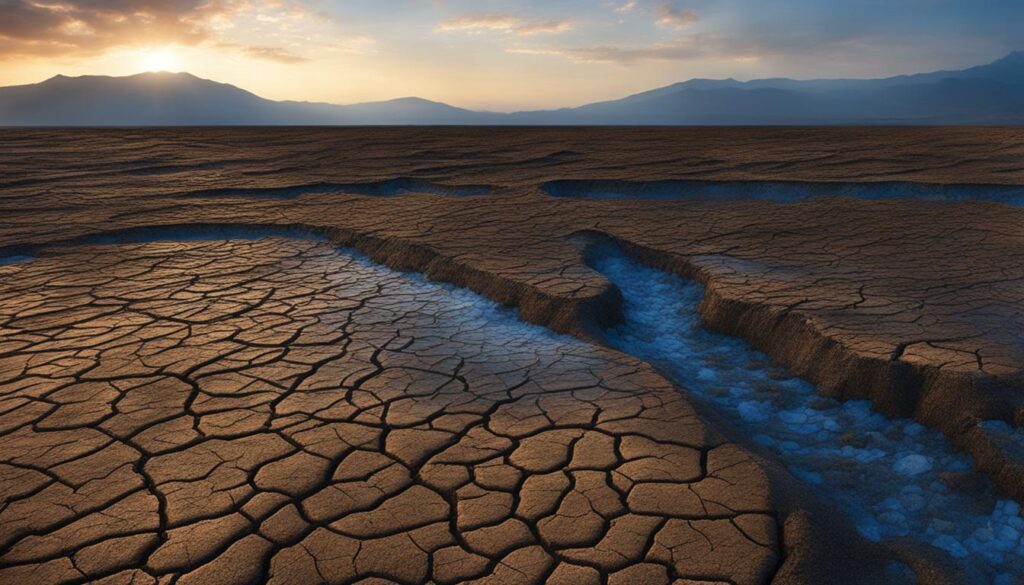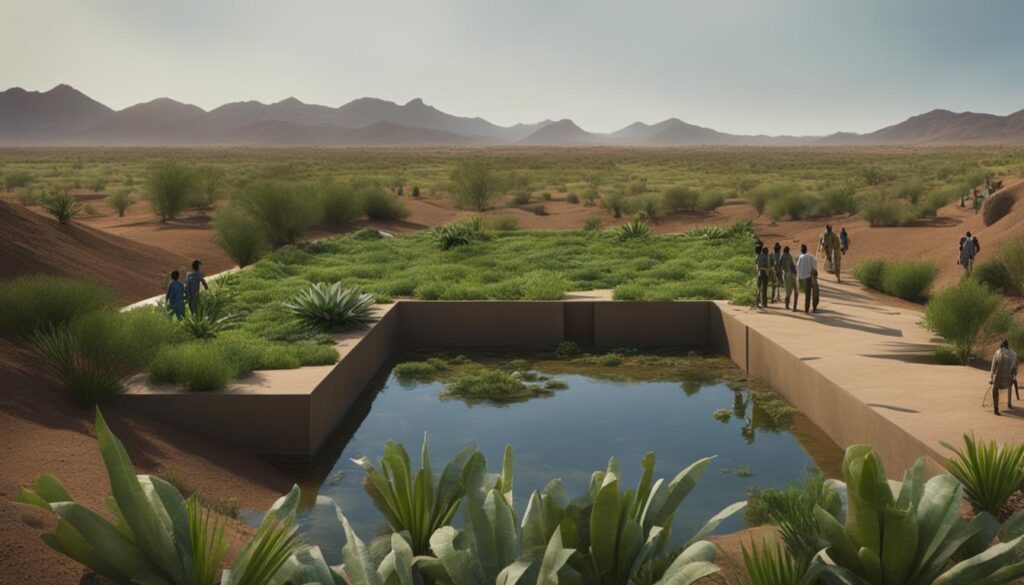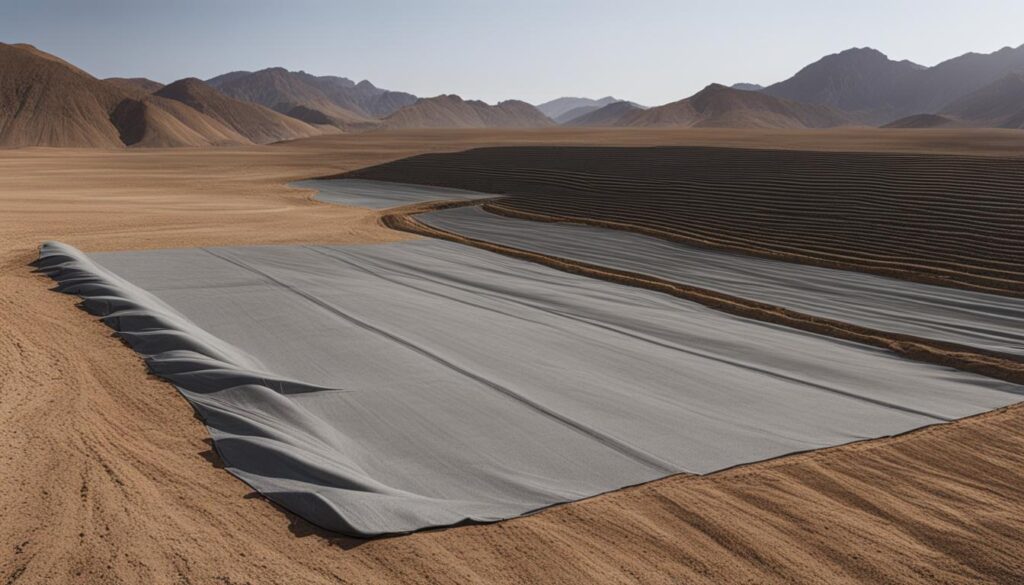Building soil structure in arid climates is crucial for ensuring the stability and durability of structures and promoting sustainable agriculture. In these challenging environments, where water scarcity is a constant concern, soil stabilization plays a vital role in transforming weak soils into a solid base for construction projects. By improving the soil’s ability to resist forces and support structures, soil stabilization methods create a strong foundation and enhance the overall performance of structures in arid climates.
To achieve effective soil stabilization, various methods can be employed, including the use of chlorides, geotextiles, polymers, fly ash, enzymatic stabilization, and mechanical stabilization. Each method has its own advantages and considerations, but all contribute to enhancing soil stability and strength.
Key Takeaways:
- Building soil structure in arid climates is essential for stability and sustainability.
- Soil stabilization methods include chlorides, geotextiles, polymers, fly ash, enzymatic stabilization, and mechanical stabilization.
- Improving soil structure enhances the performance of structures in arid environments.
- Water scarcity is a constant challenge in arid climates.
- Sustainable agriculture practices are crucial to mitigate soil erosion and water management challenges.
Understanding the Interplay between Water and Soil
Water and soil have a complex and interdependent relationship, particularly in arid climates where water availability is limited. Healthy soils play a crucial role in this dynamic, acting as sponges that absorb and store water. By doing so, they not only nourish plant life but also help shape the landscape over time. On the other hand, water provides the essential moisture that enables the growth and development of soil organisms, which in turn contribute to the overall health and fertility of the soil.
In arid climates, the challenge lies in managing limited water resources effectively. Water scarcity, water pollution, and competing demands for water can all impact the availability and accessibility of water for both agricultural activities and ecological stability. To address these challenges, sustainable water management practices have been developed to improve water infiltration and retention in arid soils.
One such practice is rainwater harvesting, which involves capturing and storing rainwater for later use. This method helps replenish groundwater reserves and provides a valuable water source for irrigation during dry periods. Micro-irrigation systems, such as drip and sprinkler irrigation, are also commonly used in arid climates. They deliver water directly to the plant roots, minimizing water loss through evaporation and ensuring efficient water usage. Soil moisture monitoring techniques provide real-time data on soil water content, allowing farmers to make informed decisions about irrigation schedules and water application rates. Mulching, another effective method, involves covering the soil surface with organic materials such as straw or wood chips. Mulch helps conserve water by reducing evaporation, regulating soil temperature, suppressing weed growth, and promoting microbial activity.
Water and Soil Relationship: Key Points
- Water and soil have an interdependent relationship in which healthy soils act as sponges, absorbing and storing water, while water nourishes and shapes the soil.
- In arid climates, sustainable water management practices such as rainwater harvesting, micro-irrigation, soil moisture monitoring, and mulching can enhance water infiltration and retention in arid soils.
- These practices contribute to efficient water usage, support agricultural activities, and maintain ecological stability in arid climates.
In conclusion, understanding the interplay between water and soil is vital for effective water management and promoting healthy soils in arid climates. By implementing sustainable water management practices, we can maximize water availability, support agricultural productivity, and ensure the long-term viability of our ecosystems.
The Impact of Soil Erosion and Challenges in Water Management
Soil erosion is a pressing issue that poses significant challenges in water management in arid climates. Unsustainable land practices, such as intensive agriculture, deforestation, and urbanization, accelerate soil erosion and lead to the loss of fertile topsoil. This not only threatens soil fertility but also has severe consequences for global food security and ecological stability. The sequel follows a discussion on the environmental and socioeconomic implications of soil erosion, as well as the challenges it presents in managing water resources in arid climates.
To address the problem of soil erosion effectively, it is essential to adopt sustainable land practices that prioritize soil conservation and restoration. Implementing strategies such as conservation tillage, cover cropping, terracing, and regenerative agriculture can help prevent soil erosion by minimizing soil disturbance, protecting the soil surface, and reducing water runoff. These practices not only help retain the fertile topsoil but also contribute to water conservation and sustainable agricultural productivity.
Moreover, managing water resources in arid climates poses additional challenges due to water scarcity, water pollution, and competing demands for limited water supplies. Climate change further exacerbates these challenges by altering hydrological cycles and triggering more extreme weather events. To address these water management challenges, it is crucial to promote sustainable practices such as rainwater harvesting, water-efficient irrigation techniques, and proper soil moisture monitoring. These approaches can optimize water infiltration and retention, ensuring efficient use of limited water resources while supporting agricultural activities and ecological stability.
By adopting sustainable land practices and implementing innovative water management strategies, we can mitigate soil erosion and address water scarcity in arid climates. It is imperative to prioritize the conservation and restoration of soil health, as well as the efficient and effective management of water resources, to ensure the long-term sustainability and resilience of ecosystems and agricultural systems in these challenging environments.
Improving Water Infiltration and Retention through Innovative Practices
When it comes to maximizing water efficiency and promoting sustainable agriculture in arid climates, innovative practices play a crucial role. Incorporating methods such as rainwater harvesting, micro-irrigation, soil moisture monitoring, and mulching can greatly enhance water infiltration and retention in arid soils.
Rainwater harvesting allows for the collection and storage of rainwater, providing a valuable water source for various uses. By capturing rainwater through systems like rooftop collection or storage tanks, you can ensure a constant supply of water even during dry periods.
| Benefits of Rainwater Harvesting | Examples |
|---|---|
| Conserves water resources | Utilizing rain barrels to collect water for gardening |
| Reduces reliance on groundwater | Installing large-scale storage tanks for agricultural irrigation |
| Controls stormwater runoff | Implementing rain gardens to capture and filter rainwater |
Micro-irrigation systems, such as drip irrigation and sprinkler irrigation, ensure precise water delivery to plants, minimizing water loss. With these systems, water is targeted directly at the root zone, avoiding wasteful evaporation and runoff.
Soil moisture monitoring technologies provide real-time data on soil water content, enabling farmers to make informed decisions about irrigation. By accurately measuring soil moisture levels, you can optimize water application, avoiding both under- and over-irrigation.
Mulching is another effective way to conserve water in arid soils. By covering the soil surface with organic materials like straw, wood chips, or compost, mulching helps regulate soil temperature, suppress weed growth, and enhance microbial activity. It acts as a protective layer, reducing evaporation and promoting water retention.
By implementing these innovative practices, you can enhance water infiltration and retention, ensuring the optimal use of water resources in arid climates. Whether through rainwater harvesting, micro-irrigation, soil moisture monitoring, or mulching, these methods contribute to sustainable agriculture and environmental resilience.
Quote:
“By incorporating innovative water management techniques, we can transform arid soils into thriving agricultural landscapes, even in the face of water scarcity.”
– Agricultural expert
Summary:
- Rainwater harvesting allows for the collection and storage of rainwater, providing a valuable water source in arid climates.
- Micro-irrigation systems deliver water precisely to plants, minimizing water loss through evaporation and runoff.
- Soil moisture monitoring technologies enable informed irrigation decisions by providing real-time data on soil water content.
- Mulching conserves water by regulating soil temperature, suppressing weed growth, and enhancing microbial activity.
Preventing Soil Erosion with Regenerative Practices
In arid climates, preventing soil erosion is essential for maintaining soil fertility, promoting sustainable agriculture, and preserving the ecological balance. Regenerative practices offer effective solutions for combating soil erosion and ensuring long-term soil health. By implementing regenerative agriculture techniques such as cover cropping, conservation tillage, and terracing, you can protect the soil from erosion and enhance its stability.
Cover Crops
Cover crops, also known as green manures, are crops specifically grown to protect the soil. They help prevent erosion by covering the soil surface, reducing the impact of raindrops and wind. Cover crops also improve soil structure by adding organic matter and enhancing microbial activity. Additionally, they help scavenge excess nutrients, preventing them from leaching into water bodies. Popular cover crops for arid climates include legumes, grasses, and brassicas, which offer various benefits such as nitrogen fixation and weed suppression.
Conservation Tillage
Conservation tillage practices minimize soil disturbance, preserving its structure and preventing erosion. Examples of conservation tillage include no-till farming and reduced tillage systems. These techniques limit the number of times the soil is tilled or plowed, reducing the exposure of the soil to wind and water erosion. Conservation tillage also helps retain moisture in the soil, mitigating the effects of drought in arid climates. By adopting conservation tillage practices, you can improve soil quality, conserve water, and reduce the risk of erosion.
Terracing
Terracing involves constructing levees and embankments on steep slopes to slow down water runoff and prevent soil erosion. By creating a series of level steps on the slope, terracing reduces the speed of water flow, allowing it more time to infiltrate the soil and minimizing erosion. Terracing also helps retain moisture in the soil, making it beneficial for arid climates. The terraced steps can be used for planting crops and trees, further enhancing soil stability and promoting sustainable agriculture.
| Regenerative Practice | Benefits |
|---|---|
| Cover Crops | – Protects soil from erosion – Adds organic matter and improves soil structure – Scavenges excess nutrients |
| Conservation Tillage | – Preserves soil structure and prevents erosion – Retains moisture in the soil – Conserves water |
| Terracing | – Slows down water runoff and prevents erosion – Retains moisture in the soil – Provides planting opportunities on steep slopes |
Building Soil Structure with Chlorides
Soil stabilization is a critical process in arid climates, and one method that has proven effective is the use of chlorides. Chlorides, such as magnesium chloride and calcium chloride, have been widely utilized for their ability to enhance soil stability and create a solid foundation for construction projects. By trapping moisture from the environment and locking it into the soil, these chlorides provide stability to the soil, similar to a ball of salt becoming hard. The result is a hard surface with minimal dust emission, suitable for various applications.
When using chlorides for soil stabilization, they can be mixed into the top layers of soil or sprayed on the surface. This ensures that the chlorides penetrate the soil and bond with the particles, creating a strong and stable structure. However, it is important to note that reapplication of chlorides may be necessary after rainfall or snowmelt to maintain the stability of the soil.
Chlorides play a vital role in creating a stable foundation and improving the overall performance of structures in arid climates.
While chlorides have been proven effective for soil stabilization, it is essential to consider environmental concerns. Increased chloride levels can have adverse effects on the surrounding ecosystem, so it is crucial to assess the potential impact before implementing chloride-based stabilization methods.
Comparative Analysis of Chloride Stabilization
| Chloride Type | Advantages | Considerations |
|---|---|---|
| Magnesium Chloride | Provides excellent dust control Enhances soil stability Readily available |
May have environmental impact Requires reapplication after precipitation |
| Calcium Chloride | Effective for stabilization Helps reduce soil dust Widely used and accessible |
Potential environmental concerns Reapplication needed after rainfall |
Table: Comparative analysis of chloride stabilization methods
Chlorides are valuable tools for soil stabilization in arid climates, but it is essential to weigh their advantages against potential environmental considerations. Implementing chlorides for soil stabilization requires careful evaluation and monitoring to ensure the best results while minimizing any potential adverse effects.
Enhancing Soil Stability with Geotextiles
Geotextiles are a valuable tool for soil stabilization, erosion control, and drainage in arid climates. These materials, available in various forms such as woven materials and thick plastic extrusions, enhance the stability of soil and prevent the displacement of the top layer due to rain or water. Geotextiles can be used in a wide range of applications and are compatible with most soil types. They offer long-lasting effects and permanent solutions, making them an excellent choice for projects where soil stability is crucial.
One of the primary benefits of geotextiles is their effectiveness in erosion control. By providing a protective layer, geotextiles prevent soil particles from being washed away by water runoff, reducing the risk of soil erosion. They also contribute to improved drainage of water, allowing excess moisture to flow through the geotextile while retaining the soil particles.
When used in road construction, geotextiles offer significant advantages. Thicker extrusion geotextiles provide the necessary strength to support the weight and traffic load of vehicles. They help distribute the load more evenly, reducing the stress on the underlying soil and extending the lifespan of the road. Geotextiles also minimize the formation of potholes and cracks caused by water infiltration and freeze-thaw cycles, ensuring a smoother and safer road surface.
Overall, geotextiles are a reliable solution for enhancing soil stability, controlling erosion, and improving drainage in arid climates. Their versatility, compatibility with various soil types, and long-lasting effects make them an essential component of construction and infrastructure projects. By incorporating geotextiles into soil stabilization efforts, you can ensure the durability and performance of structures while promoting sustainable land practices.
Table: Applications of Geotextiles in Different Industries
| Industry | Application |
|---|---|
| Construction | Soil stabilization for roads, foundations, and embankments |
| Agriculture | Erosion control, mulching, and weed suppression |
| Landscaping | Slope protection, retaining walls, and landscape design |
| Environmental | Landfill liners, erosion control in water bodies, and wetland restoration |
| Mining | Heap leach pads, tailings management, and soil reinforcement |
Polymer Soil Stabilization: Bonding Soil Particles Together
Polymer soil stabilization is a highly effective method for enhancing the physical properties of soil in arid climates. By introducing polymers, which are chemical compounds with repeating molecular chains, into the soil, it is possible to bond soil particles together, creating a strong and stable foundation.
“Polymer stabilization offers an impermeable surface and contributes to soil stability and strength.”
The use of synthetic polymers in soil stabilization provides robust binding properties, creating a durable and long-lasting surface. However, it is important to consider the potential environmental concerns associated with synthetic polymers. Biopolymers, on the other hand, offer a more environmentally friendly alternative, although they may not provide the same level of strength as their synthetic counterparts.
The Benefits of Polymer Soil Stabilization:
- Enhances soil stability and strength
- Creates an impermeable surface
- Reduces erosion
- Improves load-bearing capacity
- Minimizes dust emissions
Overall, polymer soil stabilization is an effective solution for bonding soil particles together and improving the stability of structures in arid climates. It offers a range of benefits, from enhancing load-bearing capacity to reducing erosion. Whether utilizing synthetic or biopolymers, this method can contribute to creating a solid foundation for construction projects in challenging environments.
Table: Comparison of Synthetic and Biopolymers for Soil Stabilization
| Property | Synthetic Polymers | Biopolymers |
|---|---|---|
| Strength | High | Lower |
| Environmental Impact | Concerns regarding toxicity | More environmentally friendly |
| Compatibility | Compatible with most soil types | May not be suitable for all soil types |
| Lifespan | Long-lasting | Varies depending on specific biopolymer |
Utilizing Fly Ash for Soil Stabilization
When it comes to soil stabilization in arid climates, one promising method is the use of fly ash, a byproduct of coal-fired power plants. Fly ash can serve as a bonding agent that increases soil strength, making it an ideal solution for stabilizing high moisture soils. This cost-effective alternative to lime or cement offers permanent and long-lasting results, making it a preferred choice in construction projects.
There are two main types of fly ash: Class F and Class C. While both types have their unique characteristics, they are compatible with most soil types. Fly ash stabilization creates an impermeable surface that improves soil stability and strength. However, it is important to note that the application of fly ash may be labor-intensive, and precautions should be taken to address health concerns associated with its fine powder form.
To better understand the benefits of fly ash soil stabilization, let’s take a closer look at an illustrative comparison of its properties:
| Properties | Class F Fly Ash | Class C Fly Ash |
|---|---|---|
| Hardening Time | Slow | Rapid |
| Strength Development | Gradual | Rapid |
| Chemical Reactivity | Low | High |
| Suitability for High Moisture Soils | Excellent | Good |
By utilizing fly ash for soil stabilization, construction projects in arid climates can benefit from its compatibility with various soil types, long-lasting results, and cost-effectiveness. However, it is important to consider the specific characteristics of both Class F and Class C fly ash and ensure proper safety measures are in place throughout the stabilization process.
Enzymatic Stabilization: Transforming Soil into a Durable Surface for Unpaved Roads
Enzymatic soil stabilization is a highly effective method for creating a long-lasting and durable surface for unpaved roads in arid climates. By utilizing enzyme-based stabilizers, you can transform loose and unstable soils into a concrete-like surface that can withstand heavy traffic, erosion, and weathering. This innovative approach offers numerous advantages, including cost savings, minimal maintenance, and environmental friendliness.
Unlike traditional stabilization methods that require extensive construction and ongoing upkeep, enzymatic stabilization offers a more efficient and sustainable solution. The process involves preparing the soil through ripping, applying the enzyme-based stabilizer, and compacting it. As the enzymes react with the soil particles, they create a strong bond that results in a solid and durable surface.
One of the key benefits of enzymatic stabilization is its longevity. Treated roads can last between 10 and 15 years with minimal maintenance, reducing the need for frequent repairs and associated costs. Furthermore, enzymatic stabilizers are non-toxic and environmentally friendly, making them a suitable choice for areas near water sources or environmentally sensitive regions.
Key Advantages of Enzymatic Stabilization:
- Durable and long-lasting road surfaces
- Cost savings in construction and maintenance
- Minimal environmental impact
- Compatibility with various soil types
- Reduced need for ongoing maintenance and repairs
By harnessing the power of enzymes, enzymatic stabilization offers a reliable and effective solution for improving the stability and durability of unpaved roads in arid climates. The long-lasting results, cost savings, and minimal environmental impact make it an attractive choice for road infrastructure projects, providing safe and reliable transportation routes for communities in arid regions.
How Can Building Soil Structure Help with Xeriscaping in Arid Climates?
When xeriscaping in arid climates, using the best soil types for xeriscaping is crucial. Building soil structure with these specific soil types can help retain moisture and nutrients, which is essential for plant survival in dry conditions. Incorporating organic matter can further aid in water retention and improve overall soil quality.
Conclusion
Building soil structure in arid climates is crucial for ensuring the stability and durability of structures and promoting sustainable agriculture.
Soil stabilization methods such as the use of chlorides, geotextiles, polymers, fly ash, enzymatic stabilization, and mechanical stabilization play a vital role in creating strong foundations and improving the overall performance of structures in arid environments. These methods provide effective ways to transform weak soils into a solid base for construction projects. By utilizing innovative soil stabilization techniques, you can enhance the strength and resilience of your structures in arid climates.
In addition to soil stabilization, implementing innovative water management practices and regenerative land practices is essential in arid climates. These practices maximize water infiltration and retention, preventing soil erosion and promoting sustainable agriculture. Sustainable water management practices like rainwater harvesting, micro-irrigation, and soil moisture monitoring ensure efficient and effective water use, supporting both agricultural activities and ecological stability. Regenerative land practices such as cover cropping, conservation tillage, and terracing protect soil health, conserve water, and sustain agricultural productivity.
By prioritizing soil stabilization, implementing innovative water management practices, and embracing regenerative land practices, you can create a solid foundation for sustainable development in arid climates. These strategies not only improve the performance of your structures but also contribute to long-term environmental health and agricultural productivity. So, whether you are constructing buildings, cultivating crops, or managing land resources, these practices are key to thriving in arid environments.














